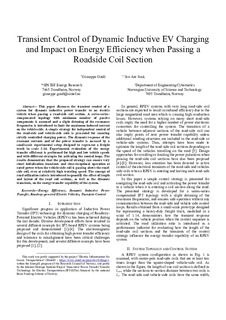| dc.contributor.author | Guidi, Giuseppe | |
| dc.contributor.author | Suul, Jon Are Wold | |
| dc.date.accessioned | 2019-01-23T15:18:55Z | |
| dc.date.available | 2019-01-23T15:18:55Z | |
| dc.date.created | 2018-06-14T09:35:43Z | |
| dc.date.issued | 2018 | |
| dc.identifier.isbn | 0-000-00001-9 | |
| dc.identifier.uri | http://hdl.handle.net/11250/2582010 | |
| dc.description.abstract | This paper discusses the transient control of a system for dynamic inductive power transfer to an electric vehicle when passing a road-side coil section. A series-series-compensated topology with minimum number of passive components is assumed and a slight detuning of the resonance frequencies is introduced to limit the maximum induced current on the vehicle-side. A simple strategy for independent control of the road-side and vehicle-side coils is presented for ensuring strictly controlled charging power. The dynamic response of the resonant currents and of the power transfer is assessed by a small-scale experimental setup designed to represent a freight truck in scale 1:14. Experimental evaluation of the energy transfer efficiency is performed for high and low vehicle speeds and with different strategies for activating the control loops. The results demonstrate that the proposed strategy can ensure very short initialization transients and close-to-optimal operation at rated power when the vehicle-side coil is passing above the roadside coil, even at relatively high traveling speed. The concept of road utilization ratio is introduced to quantify the effect of length and layout of the road coil sections, as well as the dynamic transients, on the energy transfer capability of the system. | nb_NO |
| dc.language.iso | eng | nb_NO |
| dc.publisher | Institute of Electrical and Electronics Engineers (IEEE) | nb_NO |
| dc.relation.ispartof | 2018 IEEE PELS Workshop on Emerging Technologies: Wireless Power - WoW 2018 | |
| dc.title | Transient Control of Dynamic Inductive EV Charging and Impact on Energy Efficiency when Passing a Roadside Coil Section | nb_NO |
| dc.title.alternative | Transient Control of Dynamic Inductive EV Charging and Impact on Energy Efficiency when Passing a Roadside Coil Section | nb_NO |
| dc.type | Chapter | nb_NO |
| dc.description.version | acceptedVersion | nb_NO |
| dc.identifier.doi | 10.1109/WoW.2018.8450893 | |
| dc.identifier.cristin | 1591083 | |
| dc.relation.project | Norges forskningsråd: 256422 | nb_NO |
| dc.description.localcode | © 2018 IEEE. Personal use of this material is permitted. Permission from IEEE must be obtained for all other uses, in any current or future media, including reprinting/republishing this material for advertising or promotional purposes, creating new collective works, for resale or redistribution to servers or lists, or reuse of any copyrighted component of this work in other works. | nb_NO |
| cristin.unitcode | 194,63,25,0 | |
| cristin.unitname | Institutt for teknisk kybernetikk | |
| cristin.ispublished | false | |
| cristin.fulltext | postprint | |
| cristin.qualitycode | 1 | |
